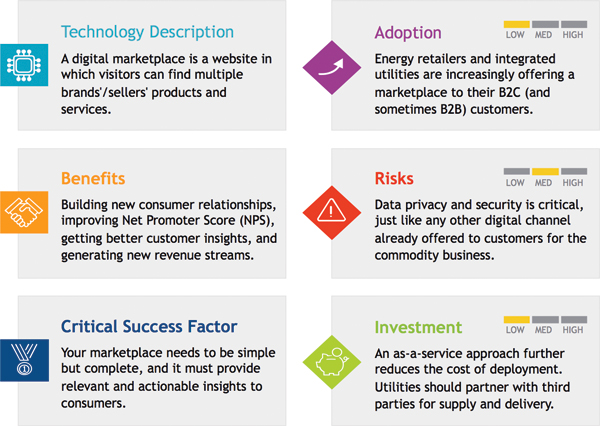Growing the top line by finding new business models and revenue streams while carving efficiencies out of the operations of the traditional commodity business continues to top utilities’ agendas, especially in Europe and more broadly, in competitive energy markets. The good news for utilities is that they have a customer base to work on. The bad news is that their customers (and more generally, consumers) do not have a great opinion about them. Several IDC studies find that consumers believe utilities do not understand their needs, find them difficult to deal with, and do not feel supported when they need their advice. Thus, it comes as no surprise that in Europe, for instance, most energy suppliers have a negative Net Promoter Score (NPS) and that many incumbent players have lost market share in favor of new digital and more demand-centric entrants. In the U.K., for instance, OFGEM data finds that in 2017, new energy retailers captured about 18 percent of the market by effectively engaging customers in an unexciting but vital product: electricity.
Energy retailers are seeking to transform themselves from commodity providers into energy advisors, capable of supporting a consumer’s connected lifestyle and delivering value-added services and products. IDC predicted, that, “by 2020, 50 percent of competitive-market energy providers will drive their revenues by transforming into convenient lifestyle providers.” However, IDC also stated that in “failing to deliver superior customer experiences, only one in five utilities will raise customer satisfaction scores by 10 percent, or reach positive NPS by 2018.”
To successfully transform, energy retailers must engage their customers in a truly effortless experience — an experience that is meaningful to the customer as an individual, available when it matters and delivered through the most convenient channel in a continuous, consistent and relevant manner.
But what if energy retailers do not know their customers? How can they provide them with relevant advice or suggest relevant products or services? And, if consumers do not trust their energy suppliers, what chance do they have of cross-selling or influencing broader consumer behavior, such as buying behavior?
Becoming an energy advisor relies on helping customers make better decisions in a broader, more holistic context. This can, and should, include advising consumers on buying decisions for energy-efficient products for the home.
Online product and appliance marketplaces provide a foundation for utilities to build consumer relationships and help them transform into trusted energy advisors.
A digital marketplace is a website in which visitors can find multiple brands’/sellers’ products and services. Since marketplaces aggregate products from a wide array of providers, selection is usually wider than on a vendor-specific online retail store. In many cases, the marketplace operator may process sale transactions. In many others, it enables visitors to directly access sellers’ e-commerce portals.
The marketplace operator business model is typically multifaceted: from affiliate marketing fees, to advertising and lead generation, and data capture and monetization.
Energy-/utility-centric marketplaces usually enable browsing a vast range of energy-related products, typically for homes, including televisions, refrigerators and freezers, projectors, washing machines and dryers, dishwashers, air conditioners, light bulbs, monitors, tablets, video games consoles, etc. Digital marketplaces can power relationships both with consumers and business customers (B2C and B2B).
Digital Marketplaces’ Adoption
In the past few years, online marketplaces have boomed outside the utility industry, since they provide value to buyers, making their search and choice easier. Some marketplaces have a wide variety of general-interest products that cater to almost all consumer needs. Others are specific to some product categories or customer segments.
In the utility sector, U.S. companies have pioneered the adoption of digital marketplaces to empower their energy-efficiency programs and simplify the rebates process for customers. For example, Con Edison has deployed two marketplaces, one specific for B2B and one for B2C. Another good example is the SDG&E Marketplace, which enables customers to browse and compare a vast variety of products across an array of consumer electronics, home appliances, heating, ventilating and air-conditioning (HVAC) systems, smart home devices and lighting. The marketplace does not sell them — it points customers to places where these products can be purchased.
In Europe, energy retailers have also started introducing marketplaces to transform their relationships with customers. E.ON in the U.K., EDF in France and Enel in Italy are just some examples.
According to IDC’s 2018 top 10 predictions for utilities: “In 2018, in targeting Millennials, gas and electricity suppliers will dedicate 50 percent of their customer-experience–related IT budgets to digital channels, product marketplaces and personalized services, leading to gains of up to two points in their customer effort scores.”
What are the Benefits for Utilities?
To transform their relationships with customers, utilities are looking for opportunities to provide valuable and relevant information. They want to advise their customers on how to become more energy efficient; they want to provide value-added services and products. Marketplaces are acquisition and engagement platforms — a way to generate new revenues, win new customers and reduce churn. They enrich relationships and make it easier for consumers to search, filter and ultimately, decide.
Marketplaces are a source of new revenues for utilities. Affiliate fee programs (and cost-per-click programs) from sellers generate payments for each customer that purchases from having used a marketplace. If the platform is credible and engaging for the consumer (resulting in high traffic figures), there are also opportunities for advertising and brand sponsorship revenues.
Marketplaces enable energy retailers to become advisors. By suggesting energy-efficient home appliances, for instance, energy retailers enable consumers to make sustainable choices, transform their relationships and prove their value as advisors. It is not easy for consumers to buy energy-efficient products; most products now score A+ and better, but these labels can be confusing, and most importantly, they do not make it easy for consumers to understand the financial impact of their choices. Current labeling does not provide accessible and relevant information for consumers on the cost of ownership; at best, it restricts consumers to making a good choice rather than the best choice.
Marketplaces are a way to transform the traditional transactional relationship that utilities have with their customers (i.e., you consume, we bill you) into a meaningful relationship beyond the commodity (i.e., we understand your life, let us advise you). Innovative and personalized content along with a unique shopping experience creates an opportunity to engage previously hard-to-reach customers. Marketplace users appreciate the service. Meanwhile, utilities that have a marketplace see improvements in their brand perception.
Marketplaces attract customers to utilities’ websites and accustom customers to consider them as a source of value. This also helps costumers move toward digital interactions, and in doing so, reducing the cost of service. Additionally, increasing levels of traffic and interaction in the marketplace make it easier — and cheaper — for energy retailers to reach out to their customers.
Marketplaces are also a powerful tool for energy retailers to get to know their customers better. Gathering visitors’ data and understanding their online behavior opens up new opportunities to improve and predict consumer choice, and to design, adopt and refine myriad suitable and effective initiatives.
Bring customers to your digital marketplace
From a business perspective, the major risk is that the customers ignore or do not visit and revisit the energy retailer’s marketplace. Two key questions need to be answered:
- How do you drive today’s online shoppers to an energy retailer’s marketplace, and how do you ensure they return?
- How can an energy retailer encourage non-online customers to leverage its marketplace?
To be successful, the launch of a new marketplace needs to be complemented by a targeted marketing campaign. Display campaigns can be designed using products that are most trendy. It has been demonstrated that social media influences online shoppers. Email marketing is both a cheap and effective solution to attract customers. For instance, it is possible to send info about new products, sales and promos. Mails can be sent to clients that haven’t been active in awhile with original content, such as editorial buying guides, price updates and saved searches to drive revisits. Paper bills are also an important moment to encourage consumers to start using digital channels, as a marketplace can represent a good reason to start visiting the energy retailer’s website. In all cases, having access to rich product and market data allows the utility to leverage these channels in the most cost-effective and agile way.
A Call to Action
The availability of a products and appliances marketplace is an interesting opportunity for energy retailers to provide new value-adding services and transform their customer relationships.

Figure 1: Digital Marketplaces: Snapshot
Source: IDC, 2018
Utilities that plan to deploy a marketplace should consider the following:
- Have a clear goal in mind. Companies need to understand what they want to achieve with the deployment of a marketplace and plan accordingly. Is it to directly sell products and make money off sales? Is it to influence buying behavior as an energy advisor and make money from affiliated sellers’ fees? Directly selling goods and being an advisor may not be compatible options in the eyes of consumers.
- De-risk your choice. If you choose to directly sell products and appliances, be ready to manage not only the positive but also the negative impact that other brands may have on yours, especially if your suggested suite of products is limited. What happens if the product you are selling breaks down? Additionally, be ready to manage the product sales cycle and related fulfillment consistently, at least with the same consistency as the competition.
- Make your marketplace valuable and complete. Regardless of your choice, your marketplace needs to be simple and provide relevant and actionable insights to consumers. If you want consumers to visit your marketplace and not others, it needs to have something highly distinctive and valuable that aids their decision-making process. You also need to offer a wide variety of choices for each product category (even better, all available goods). If you decide to restrict the choice to some brands, you need to consider the risk of consumers querying and judging your choice.
- Decide whether to make or buy. This is the typical old dilemma — should you develop your own custom marketplace, or leverage an available platform as a service and the related capabilities it embeds? If you go for the “make” option, be sure to have the necessary data science, behavioral science and digital marketing capabilities readily available in your organization.
- Do not stop at the ecommerce gate. Energy retailers should make the most of the data coming from the marketplace. If analyzed, navigation and searches (as well as myriad other online behavior around the purchase) can be used to paint a rich picture of each visitor’s preferences and behavior and be used to predict future preferences and actions. Energy retailers should not lose this opportunity and leverage this new consumer knowledge while also building new relationships with their customers and the market.
 As vice president for IDC Energy Insights, Roberta Bigliani advises both vendors and end-user clients and is responsible for research-based advisory and consulting services for the energy industry. Her main areas of expertise includes business and IT issues relevant to the utilities and oil and gas companies, as well as digital transformation, customer experience, big data and analytics, Internet of Things, IT and operational technologies integration.
As vice president for IDC Energy Insights, Roberta Bigliani advises both vendors and end-user clients and is responsible for research-based advisory and consulting services for the energy industry. Her main areas of expertise includes business and IT issues relevant to the utilities and oil and gas companies, as well as digital transformation, customer experience, big data and analytics, Internet of Things, IT and operational technologies integration.







